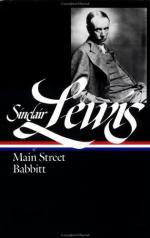She fancied that his even grayness might reveal a thousand tints of lavender and blue and silver.
At supper he hinted his love for Sir Thomas Browne, Thoreau, Agnes Repplier, Arthur Symons, Claude Washburn, Charles Flandrau. He presented his idols diffidently, but he expanded in Carol’s bookishness, in Miss Sherwin’s voluminous praise, in Kennicott’s tolerance of any one who amused his wife.
Carol wondered why Guy Pollock went on digging at routine law-cases; why he remained in Gopher Prairie. She had no one whom she could ask. Neither Kennicott nor Vida Sherwin would understand that there might be reasons why a Pollock should not remain in Gopher Prairie. She enjoyed the faint mystery. She felt triumphant and rather literary. She already had a Group. It would be only a while now before she provided the town with fanlights and a knowledge of Galsworthy. She was doing things! As she served the emergency dessert of cocoanut and sliced oranges, she cried to Pollock, “Don’t you think we ought to get up a dramatic club?”
CHAPTER VI
I
When the first dubious November snow had filtered down, shading with white the bare clods in the plowed fields, when the first small fire had been started in the furnace, which is the shrine of a Gopher Prairie home, Carol began to make the house her own. She dismissed the parlor furniture—the golden oak table with brass knobs, the moldy brocade chairs, the picture of “The Doctor.” She went to Minneapolis, to scamper through department stores and small Tenth Street shops devoted to ceramics and high thought. She had to ship her treasures, but she wanted to bring them back in her arms.
Carpenters had torn out the partition between front parlor and back parlor, thrown it into a long room on which she lavished yellow and deep blue; a Japanese obi with an intricacy of gold thread on stiff ultramarine tissue, which she hung as a panel against the maize wall; a couch with pillows of sapphire velvet and gold bands; chairs which, in Gopher Prairie, seemed flippant. She hid the sacred family phonograph in the dining-room, and replaced its stand with a square cabinet on which was a squat blue jar between yellow candles.
Kennicott decided against a fireplace. “We’ll have a new house in a couple of years, anyway.”
She decorated only one room. The rest, Kennicott hinted, she’d better leave till he “made a ten-strike.”
The brown cube of a house stirred and awakened; it seemed to be in motion; it welcomed her back from shopping; it lost its mildewed repression.
The supreme verdict was Kennicott’s “Well, by golly, I was afraid the new junk wouldn’t be so comfortable, but I must say this divan, or whatever you call it, is a lot better than that bumpy old sofa we had, and when I look around——Well, it’s worth all it cost, I guess.”




